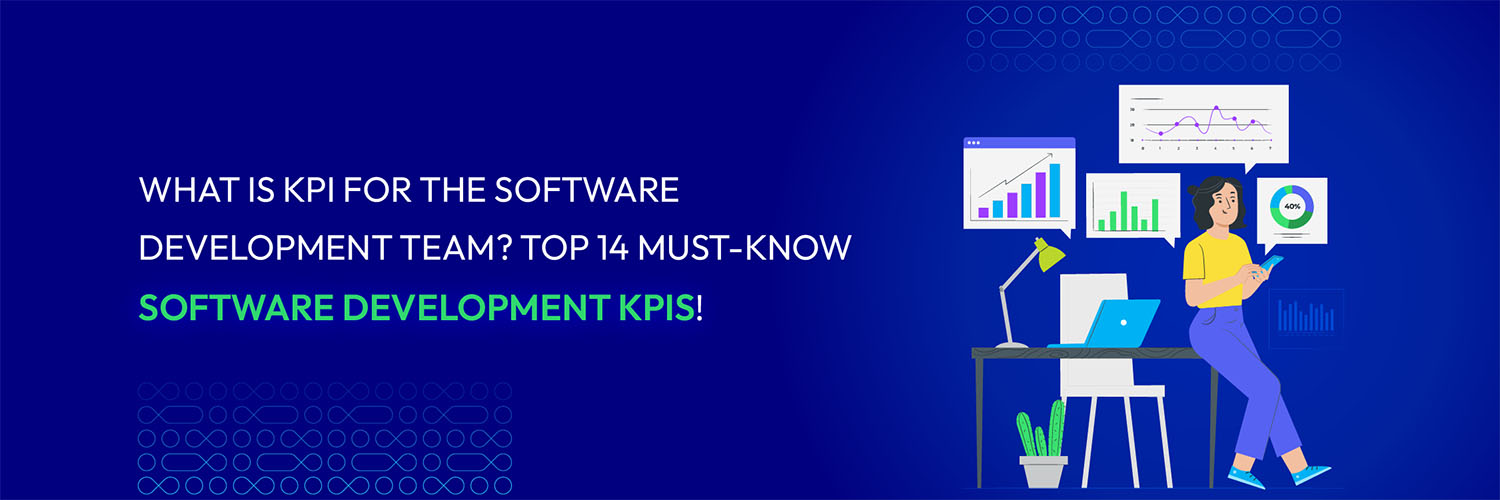Top 14 Essential Software Development KPIs
Vinh Jacker | 07-31-2023

The ever-growing demand for software and applications has become increasingly prominent each day due to the rising trend of online shopping. Do you know that by 2028, software development operations will grow by 21%?
Undoubtedly, implementing software is indispensable for building and facilitating new applications to assist users and customers. Setting KPIs for the software development team is essential to optimize the software development process.
This will be beneficial to businesses in many aspects. Let’s discover the TOP 14 must-know KPIs, along with their benefits and ways to attain them!
What is Software Development KPIs?
Key Performance Indicator or so-called Software Development KPIs refers to a metric that measures and assesses the team’s performance and progress concerning achieving specific targets.
Software development team KPI plays a vital role as it assists businesses in evaluating and prioritizing team goals as well as project objectives. Furthermore, setting KPIs for the development team also provides businesses with a comprehensive report of the current software development progression status.

With particular key performance indicators, businesses can track and optimize the software development process. The benefits of setting KPIs for the software development team include:
-
Goal Alignment: Aligns software development efforts with organizational objectives.
-
Identify Strengths and Weaknesses: Helps pinpoint areas of excellence and areas needing improvement.
-
Focus on Improvement: Guides targeted improvements in development processes and practices.
-
Enhanced Coaching and Training: Facilitates more directed coaching and specialized training opportunities.
-
Increased Development Opportunities: Opens up avenues for growth and development within the team.
-
Tangible Business Benefits: Leads to measurable improvements in productivity, efficiency, and project success rates.
TOP 14 Must-know Software Development KPIs
As mentioned above, the better the KPIs are set, the more advantages businesses will win. The list below will indicate the TOP 14 must-know software development KPIs companies can use to optimize their software development process.
1. Velocity
Velocity is a method to measure the quantity of work completed during a sprint by a development team. This measuring method indicates a team’s productivity and ability to deliver their value.
This process of calculating the amount of work accomplished by the team within a specific timeframe will benefit organizations as it provides further insights into the software development team’s productivity, thus assisting capacity planning and forecasting.
2. Cycle time
Cycle time is a metric used to calculate the time needed for a specific process or workflow finished by a work item. Regarding software development, cycle time can measure the duration required for the user story, feature, or task to proceed from the beginning of the development process until its accomplishment stage.
Measuring cycle time empowers teams to establish standards, set performance goals, and recognize process optimization and ongoing development opportunities. Teams can further win numerous benefits, such as increased agility, responsiveness, and a higher ability to deliver more efficient value to customers and end-users.
3. Code quality
Code quality is vital in deciding a software system’s reliability, maintainability, and user impression efficiency. As a result, code quality can be an indispensable Key Performance Indicator (KPI) for software development teams due to its influence.
High code quality will eliminate the risks of bugs, errors, and software failures. Teams can access its software validity and stability by measuring code quality metrics, including code reviews, unit test coverage, or defect density. Improvement in code quality will increase software ability, minimize critical production resource occurrence, and enhance customer satisfaction.
4. Customer satisfaction
Users or targeted customers are the objectives many organizations mainly focus on when building their software browsers. Except for the software development teams, customers are the ones who have high exposure to the organization’s software browser.
As a result, customer satisfaction can be a key performance indicator for software development teams due to its ability to deliver value and a direct reflection of the team’s efforts in meeting the customer’s requirements.

Tracking customer satisfaction can also be an excellent opportunity for software development teams to gain insights into their indispose areas that need to be improved, recognize their pain points, and make suitable decisions to attain better user experience.
5. On-time delivery
On-time delivery can be considered a key performance indicator (KPI) for software development teams as the team’s ability to finish project deadlines on time as well as their commitment to the project, is shown by measuring this metric.
Making on-time delivery a KPI means effective project management, customer satisfaction, and resource optimization are necessary for overall business success. This plays an essential role in creating a culture of responsibility, strictness, and professionalism within the team. Hence, resulting in better outcomes and stronger relationships with customers and stakeholders.
6. Defect density
Defect density is a key performance indicator (KPI) for software development teams because it can provide organizations with detailed information about the quality of produced software. Defect density helps software teams to calculate defects or bugs number in the software per unit of code performance.
By analyzing and controlling defect density, software development teams will be able to maintain high quality, minimize costs, generate better customer satisfaction, strengthen productivity, and navigate constant improvement.
This must-have KPI will enhance teams to convey software with fewer defects, thus leading to better overall outcomes for the organization and its users.
7. Team morale
Team morale is generally not a typical and traditional Key Performance Indicator (KPI). However, this still can be considered a critical metric due to its influence on the success of a performance and software development team.
Tracking and nurturing team morale can be performed through regular estimation, promoting a positive work culture, recognizing and rewarding achievements, attaining growth opportunities, and establishing a comprehensive and encouraging environment.
![]()
By prioritizing team morale, an optimistic and high-performing work environment will be created to contribute to the organization’s overall success.
8. Employee turnover
Employee turnover is an important Key Performance Indicator (KPI) for software development teams because it gives organizations information about the rate at which employees stay or leave the team and the organization.
As an important KPI, the process of recording employee turnover as a KPI will enable software development teams to identify trends, evaluate the associated charge, tackle the underlying causes, and apply strategies to attract talent.
Moreover, by encouraging a positive work environment, supplying growth opportunities, and taking care of employee satisfaction, the turnover rate will be reduced, productivity will be enhanced, the project progression will be maintained, and the overall team performance will be improved.
9. Time-to-market
Time-to-market refers to measuring the speed at which software products and features are publicly available. As a reason, it has become one of the most important KPIs for software development teams.
To make time-to-market a KPI, software development teams must prioritize agility, speed, customer satisfaction, and revenue generation. Additionally, a sense of urgency and efficiency, as well as a focus on creating solutions for software problems at the right time, is also generated in this process.
A faster time-to-market will undoubtedly provide organizations with a significant competitive advantage and contribute to their overall success.
10. Stakeholder engagement
Stakeholder engagement is a key performance indicator (KPI) for software development teams. By measuring stakeholder engagement, organizations will have further information about how effective and collaborative the teams have involved with stakeholders during the development process.
Effective engagement between organizations and stakeholders ensures that the team fully understands and addresses stakeholders’ demands. Thus, aligning development efforts, controlling threats, embracing feedback, and eventually displaying software that meets or exceeds stakeholder expectations.

This process will facilitate cooperation, create relationships, and generate successful overall project outcomes.
11. CFR (Change Failure Rate)
Change failure rate estimates the success and failure rate of changes made to software systems or applications. By tracking change failure rate as a KPI, software development teams can determine which areas need to be improved, boosting the quality of changes, minimizing risks, and maintaining a more steady and dependable software environment
Furthermore, CFR also emphasizes quality, risk management, customer satisfaction, and functional efficiency, thus contributing to the software projects and overall team performance success.
For these reasons, it is undeniable that CPR is an essential key performance indicator (KPI) for software development teams.
12. Net promote score
Net Promoter Score (NPS) is a metric to estimate customer satisfaction and loyalty level towards the products developed by a team. By considering NPS as a KPI, software development teams can have a direct measure and track of the satisfaction of customers, the experience of users, the quality of products, and the loyalty of customers.
These pieces of information can become valuable basis and insights for organizations to make informed improvements, focus on enhancement, and display a software product that can captivate customers. A high NPS not only emblems customer satisfaction but also facilitates the overall success and growth of the software and the business.
13. Technical debt
Generally, technical debt is not a key performance indicator (KPI) for software development teams. It is more commonly a concept representing the assembled results of substandard design or implementation options made throughout development.
However, tracking and controlling technical debt is required for the software project’s everlasting success and sustainability. This process is crucial for the software development team if they want to maintain the quality of code, system stability, and development velocity.
By actively tackling technical debt, teams will gain many advantages, such as a decrease in risks, an improvement in maintainability, an enhancement in software performance and reliability, as well as a guarantee of long-term success for the project.
14. Agile/Scrum Metrics
For organizations that follow the Agile or Scrum methodologies, Agile/ Scrum metrics can be useful key performance indicators (KPI) for software development teams. These metrics can come up with detailed and valuable insights into the team’s productivity, progress, and efficiency in delivering software projects.
By utilizing these metrics, teams can strengthen predictability, capacity, stakeholder engagement, standard, and partnership, thus resulting in software delivery success and customer satisfaction.
How to Set KPI for Software Development?
The list below will provide 5 crucial steps organizations can apply to keep track of their software development team’s KPIs.
Step 1. Define clear and specific KPIs
Organizations can start measuring KPIs by clarifying the exact objectives they want to measure. All the specific areas that need to be focused on, including productivity, quality, customer satisfaction, or team cooperation, must be identified in advance. This first and foremost process will ensure that the objectives align with the software development team and organization’s overall goals.
Step 2. Gather Data
After defining clear and specific impartial KPIs, the next important step is to gather data. If teams want to measure the selected KPIs, it is a must to determine the data sources and collect required measurable methods.

This process may involve collecting data from numerous resources, tools, and team members. Teams can utilize project management or development tools, control systems, time-tracking software, and many other relevant sources to gather the required data.
Step 3. Set Up Tracking Systems
Setting up tracking systems is applying a tracking system by utilizing software tools to capture the required data. This process may include many tasks, namely dashboards set up, automated data collection, and more, to ensure that data gathering is reliable and consistent.
Step 4. Regular Data Collection
Another important step is regularly and consistently collecting data depending on the defined frequency. This data collection process can last daily, weekly, or even monthly, regarding the KPIs being measured. However, this process will ensure accurate and up-to-date data for the teams.
Step 5. Data Analysis
One more crucial step to measure KPIs for the software development team is to create an analysis of collected data to estimate the productivity of the software development team against the defined KPIs. By measuring the relevant metrics and comparing them to the target values has been set, organizations will be able to recognize trends, patterns, or even areas that need to be improved.
Conclusion
KPIs for the software development team are significantly important, as they assist organizations in many aspects, such as goal alignment, performance measurement, decision-making improvement, performance transparency, and more.
To conclude, setting KPIs for software development teams is necessary for organizations to achieve targeted goals, improve overall outcomes, and deliver high-quality software solutions.





![Top 20+ Must-have Shopify Apps for 2025 [Free & Paid] - Mageplaza](https://cdn2.mageplaza.com/media/blog/must-have-shopify-apps/top-must-have-shopify-apps.png)
![[2025 Updates] Top 10+ Upsell Apps for Shopify - Mageplaza](https://cdn2.mageplaza.com/media/blog/best-upsell-shopify-app/cover.png)